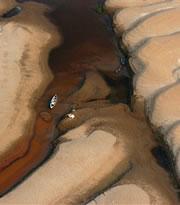 A boat tries to make its way through a section of the Amazon River suffering from lower water levels near Uricurituba, in northern Brazil, on Tuesday, Oct. 4, 2005.© AP Photo/A Critica, Euzivaldo Que
A boat tries to make its way through a section of the Amazon River suffering from lower water levels near Uricurituba, in northern Brazil, on Tuesday, Oct. 4, 2005.© AP Photo/A Critica, Euzivaldo QueParts of the Amazon rainforest are enduring the worst drought for 40 years, prompting local government to declare several cities in the Brazilian state of Amazonas as disaster areas. Researchers say that rising sea temperatures in the North Atlantic, perhaps prompted by climate change, are probably to blame.
Researchers at a forest monitoring station in Santarém, where the Amazon and Tapajós rivers meet, report that water levels are some 15 metres lower than usual.
"Everybody has been taken by surprise," says Paul Lefebvre, a researcher at the Woods Hole Research Center in Massachusetts, which runs the station.
Droughts in South America are often associated with El Niño climate events - oscillating changes to weather patterns that occur as a result of periodic warming of southern Pacific waters. But researchers have not spotted any such warming this year, Lefebvre says.
Instead, rising surface temperatures in the North Atlantic could be the culprit. The waters have been unusually warm this year - as shown to devastating effect by this year's unusually destructive tropical hurricane season.
The pressure's on
The warm waters tend to encourage evaporation, leading to low pressure systems over the Atlantic. This creates storm conditions that carry water and energy towards the United States. But it also sets up high pressure systems over neighbouring regions further south, such as the Amazon. High pressure systems tend to carry less cloud and provide less rainwater.
The Amazon Basin shows wide seasonal variation in rainfall, Lefebvre points out. But with the wet season not due to begin until December, local communities are fearful that the current lack of water may harm fish supplies and increase the risk of disease.
Drought in the Amazon could also stunt tree growth and make the forest more susceptible to burning - both of which could have global implications for climate.
Studies by Lefebvre's colleagues show that drought conditions can cut the amount that trees grow by a quarter, which would in theory prevent the forest's ability to soak up carbon.
If this happens, the Amazon could conceivably become a carbon 'source', pumping out carbon dioxide faster than it can absorb it, Lefebvre says. More carbon dioxide in the atmosphere could raise world temperatures even further, making droughts even more damaging in the future.
Tinder box
ADVERTISEMENT
Forest burning, often used to remove insect pests or encourage grass growth for grazing animals, could also fall into a similar vicious cycle, Lefebvre says. "Fire damage sets up a process where the forest becomes more susceptible to the next burn," he says. Local governments have tried to limit the number of burning permits issued, but many people are too poor to afford them, and so ignore the regulations.
The ultimate fear is that the Amazon forest - often touted as an invaluable piece of armour against climate change - could become part of the problem rather than a key element of the solution. Droughts make it more likely that it will become a net source of greenhouse gases to the atmosphere, rather than mopping them up.
"From hearing what people are saying, I'm quite alarmed," Lefebvre admits. "It's an interesting time to be studying this, but it's not good news."
